Alternatives in the Face of Chemical Diversity
LCGC North America
In this month's "MS-The Practical Art," Michael Balogh takes a closer look at insight provided by Chuck McEwen regarding obstacles while using solvents.
Many of today's analytical practitioners, their primary training notwithstanding, separate compounds using liquid chromatography–mass spectrometry (LC–MS). In so doing, they depend upon solvents to transport their samples into a mass spectrometer's source, where the samples are (usually) ionized from solution. Yet, the solvent that is so essential to this process also presents a downside. Besides limiting by dilution the absolute amount of sample provided for analysis, the solvent plays a significant role in mediating the kind of ions you can see and the kinds of materials the instrument can ionize. So, understandably, mass spectrometrists have long sought a way to rid themselves of the solvent and its effects so that they could ionize more species. One attempt at doing this in the gas phase was atmospheric pressure chemical ionization (APCI), invented in the 1970s by Horning's group (1). But in the last 25 years, APCI, like other alternatives to electrospray ionization (ESI), seemingly has been left in the wake of ESI's overwhelming popularity.
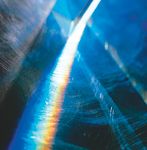
At CoSMoS, in July 2006, Chuck McEwen, a scientist at DuPont's Corporate Center for Analytical Sciences Wilmington, Delaware, offered insight into his work, insight that proves quite interesting.
The diversity of analytical requirements he faces in his laboratory impelled McEwen to rethink the APCI approach to mass analysis. He calls one recently published outcome (2) the atmospheric pressure solids analysis probe, or ASAP, method. The acronym "ASAP" is appropriate, because ASAP is a rapid method of analyzing volatile and semivolatile compounds in solids, liquids, polymers, and biological tissue, which gives it a fairly wide utility. A second, almost obvious approach aimed at overcoming the solvent problem directs a gas chromatography (GC) outflow into an unmodified LC–MS (ESI) instrument (3).

Michael P. Balogh
Today's Emerging Alternatives
In recent years, several direct ionization methods have emerged that this column has addressed (4). Among them is desorptive ESI, or DESI, developed in Graham Cooks' laboratory at Purdue University (West Lafayette, Indiana) (5). In its simplest sense, DESI is an electrospray stream of charged droplets devoid of analyte that, at atmospheric conditions, is directed onto the surface to be analyzed. The droplets hit and ionize both volatile and nonvolatile materials that generally are analyzable by electrospray.
A recent extension of DESI technology from the same group is called desorptive APCI (DAPCI). In DAPCI, a charge is imposed on a needle, not directly on the liquid, as done in ESI. Liquid is still the vehicle, and charged droplets hit the sample surface where they ionize volatile materials. The compounds amenable to this technique are the same as those you would likely see in APCI.

Figure 1
Direct ionization real-time (commercialized as DART, by JEOL, Peabody, Massachusetts) has been promoted as an alternative to DESI (6). In this approach, metastable neutrals carried in a heated gas stream are thought to perform the ionization. McEwen said he does not see much difference between the published results of the direct ionization real-time method and his own ASAP. However, if you buy the direct ionization realtime method, you also must buy the company's source, whereas ASAP requires no additional source.
So how simple is ASAP, you might ask. Actually, it is pretty simple. The method requires access to the source, for instance using the instrument's photoionization port. Through a hole, you insert a probe holding a melting point (mp) capillary tube, the sample on its closed-end. Thus, you introduce the sample into the source and also into the heated gas flow from an APCI probe (or electrospray probe if your instrument uses heated nebulizing gas).
McEwen said:
When we first developed ASAP, I didn't think it was so important—just an atmospheric pressure solids probe. But when I saw the DART method, I realized we could obtain comparable results and do so more safely. DART and DESI sources are open, and because the method vaporizes materials (some of which can be harmful if inhaled), the open sources can pose a safety risk. ASAP uses an instrument's (enclosed) standard ion source and, except for photoionization, does not interfere with other operations.
According to McEwen, a high-resolution instrument like a QTOF (Waters Corporation, Milford, Massachusetts) or Orbitrap (Thermo Fischer Scientific Corporation, Waltham, Massachusetts) gives accurate mass measurement data on every peak in a mixture. The high mass resolution even allows separation of compounds of the same nominal mass but different elemental composition.
McEwen said that in more complex samples, because ASAP is a vaporization method, he can control the temperature to control the appearance of various materials.
For EPA 8270 Megamix, a sample containing about 80 components, we programmed the gas temperature to increase stepwise. We found that it's possible to both obtain some separation of components and reduce suppression effects, so that all the Megamix compounds could be mass measured in less than a minute. Similarly, for polymer additives analysis, all you must do is place a small piece of polymer into an mp tube and heat it with the heat supplied by your LC source to obtain mass spectra of the additives. In fact, at higher temperatures, as high as 500 °C, many polymers produce characteristic thermal fragments that you can use to identify the polymer. The ASAP method has been used with thermal gravimetric analysis (TGA) to identify the volatile components resulting in weight loss.
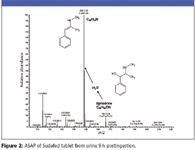
Figure 2
Figure 2 presents another practical example. A urine sample taken 9 h after a 12-h dose of the over-the-counter remedy Sudafed (Pfizer, New York, New York) shows the molecular ion of ephedrine and a fragment ion. These data were obtained simply by adding 1 μL of untreated urine to the closed-end of an mp tube and ionizing the vaporized components via APCI. McEwen explains:
Of course, there are other things in the sample. But I selected the optimum temperature to make ephedrine stand out. At higher temperature you see many more compounds. Indeed, you can expect to see anything in the urine sample that can be vaporized.
Many of us have seen the advertisements for DART in which paper currency is held in the source to detect cocaine. After seeing that demonstration, McEwen thought he should be able to achieve the same result with ASAP:
"We had been using the API solids probe for some time to analyze synthetic samples quickly. It occurs to me that of all the alternative uses until DART was announced. Thanks to the innovative ideas of DART's developers, we discovered that ASAP had similar attributes such as the nice mass spectrum of cocaine we observe from almost all used currency."
It occurs to me that such ease of adaptability extends teaching the concepts of mass spectrometry even to the undergraduate level.
No sample preparation
Imagine assaying biological tissue without first needing to prepare the sample — something as simple as taking a particle of carrot, heating it, and seeing expected components like beta-carotene. McEwen routinely has used the ASAP method for tissue analysis as well as performing other analytical chores without sample preparation. In one example, the spectrum for nepetalactone, a major leaf component of the catnip plant, is obtained easily. However, were you to put the plant in a cold, dark room and leave it there for a couple of weeks, it would become less interested in making nepetalactone and significant chemical changes would occur (Figure 3). McEwen said, "With ASAP, we immediately see the chemical changes, at least for the vaporizable components. I haven't taken the time to analyze these new components, but I do have accurate mass and MS-MS spectra if anyone wants to go through them and determine the structures."
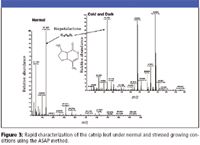
Figure 3
Atmospheric GC: A Complementary Technique
ASAP is a rapid method for analyzing samples at atmospheric pressure. It also is compatible with another alternative, atmospheric pressure gas chromatography (GC–APMS) on any LC–MS instrument, which also requires only a simple ion source modification. ESI instruments are designed to perform gas-phase ionization, so it stands to reason we can perform GC–MS analyses on an LC–MS instrument. So McEwen added a second separation method to his repertoire. APCI and, more recently, atmospheric pressure photoionization (APPI) have both been used to create ions from the GC stream with success. McEwen sums his effort:
We have basically done nothing to it [GC–APMS] but put a GC transfer line in the position normally occupied by the LC–ESI-APCI probe. We use either the standard APCI needle for the discharge or the standard Syagen [Tustin, California] APPI lamp to produce ions. For best results, the ion source must be continuously purged with a clean, dry gas like nitrogen, and the transfer line must be heated over its entire length.
There are some advantages of GC–MS over LC–MS. GC historically has provided higher chromatographic resolution than LC, and with more peak capacity, although for a narrower range of compounds. As demonstrated with the commercialization of work at ultrahigh pressures (7,8), both LC and GC are now capable of one-second-wide peaks. Yet, GC does prove itself of critical value. Given its much greater sensitivity for certain compounds, you can see compounds that are not visible with any of the liquid introduction methods. Also, because GC analytes can be introduced as solids, problems with analyte solubility are nonexistent. Finally, other advantages, like the relative ease of temperature programming compared with solvent programming, and the convenient utility of having GC handy in a predominantly LC environment, are convincing arguments for GC's presence in the laboratory.
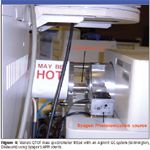
Figure 4
The bonus effect of a readily available GC system manifests itself in the surprise you experience at finding many more peaks present than those you saw using just the liquid introduction techniques. At times, a peak can appear in the UV trace but you cannot see it in the electrospray or APCI mass spectrum. McEwen explains the advantages of GC APPI over discharge-initiated APCI:
The reason is that, as opposed to the soft-ionization of APCI, APPI resembles EI. In EI, an electron generated from a filament in the MS source is used to remove an electron from the analyte creating a positive ion. Photoionization also removes electrons but with a photon. So right away you see evidence that photoionization is going to be similar to electron ionization, except that it is lower in energy. In that sense, we can think of it as low-energy electron ionization [Figure 5].
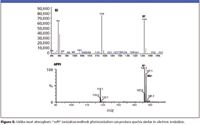
Figure 5
By comparison, the APCI mechanism is complicated. The process starts by ionizing nitrogen and finishes with protonated water and water clusters as the reagent ions. In fact, if you are using LC solvents, solvent clusters perform the ionization. The protons in the solvent clusters are solvated and less basic than H3O+, the hydronium ion. So the proton will not be transferred to analytes less basic than the solvent clusters, leaving many compounds un-ionized. In GC–APMS, a purging gas of dry nitrogen can reduce residual water to such a level that H3O+ is the predominant ionizing reagent. More acidic than protonated solvent or water clusters, H3O+ ionizes a larger range of compounds. If the ion source is made sufficiently dry, you can ionize an analyte by charge exchange, from N4+ and N2+, a reaction that provides almost universal ionization.
McEwen said this about the added analytical utility of APPI:
What I think is exciting about APPI is that the higher-mass portion of the APPI mass spectra are similar to EI mass spectra. So a modified search engine should enable identification of compounds in the NIST or Wiley libraries, especially in conjunction with the obvious molecular weights observed with APPI. For example, two methylionone isomers in a perfume sample gave reproducible differences in the mass spectra. [Figure 6] One APPI spectrum displayed a more prominent m/z 191 fragment ion relative to the molecular ion, and a less prominent m/z 149 peak. The other spectrum displayed a smaller m/z 191 response relative to the molecular ion and m/z 150 rather than m/z 149. Compared to the EI spectra, the same isomers displayed the same relative response between m/z 191 and the molecular ion and, furthermore, the m/z 149 and 150 ions matched correctly. The added benefit of GC–MS (APPI) over the higher-energy GC–MS (EI) lies in the ability of the former to identify the molecular ion easily, which stands out like a sore thumb" (8).
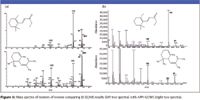
Figure 6
The higher energy EI (typically employing 70 eV electrons) introduces enough energy to the molecule to initiate a series of bond dissociations, leaving characteristic fragments but sometimes at the expense of the intact molecular ion.
McEwen points out a tantalizing prospect:
If you're using accurate mass measurement, you can narrow the possible elemental compositions that need be considered as potential matches when searching an EI generated computer library. Now you also have direct access to some fragment ions that are present in the EI library. So if you search that library in a smart manner, you should be able to identify these compounds. Photo-ionization may be an atmospheric pressure avenue to true library search capability.
Looking forward
McEwen is sanguine about his method:
We have dedicated a QTOF [system] to APGC–MS analyses because doing so allows us to obtain MS-MS spectra and get accurate mass measurement on GC–MS samples. If we need the QTOF [system] for LC, we just roll the GC [system] away.
Areas of immediate interest to practitioners were illustrated by this question raised following McEwen's CoSMoS presentation:
When analyzing materials from the probe, do you see discrimination of some analytes observed preferentially over others? Or do you see the signal more related to the relative amounts of compound? Do you see the sort of suppression effects that you do with electrospray?
This is how McEwen responded:
ASAP is first a vaporization method, followed by ionization. In any atmospheric pressure ion source, lots of collisions occur, causing the less basic analytes to transfer their charge to more basic compounds. That collision and transfer process causes discrimination. ASAP is a sensitive technique that lets you reduce discrimination by minimizing the sample and by using temperature to produce a separation. From our work, it appears that there is much less suppression in ASAP than in liquid ionization methods.
McEwen said that quantitation is the next thing he will work on. He knows that ASAP gets the correct relative responses. Whether it is truly quantitative, or whether you can make it quantitative if it is not, is the question.
Acknowledgment
Charles N. McEwen is a Research Fellow in the DuPont Corporate Center for Analytical Sciences, Wilmington, Delaware. Dr. McEwen received the B.S. in chemistry from the College of William and Mary, Williamsburg, Virginia, the M.S. degree in chemistry from Atlanta University, Atlanta, Georgia, and the Ph.D. degree in chemistry from The University of Virginia, Charlottesville, Virginia.
Michael P. Balogh "MS — The Practical Art" Editor Michael P. Balogh is principal scientist, LC–MS technology development, at Waters Corp. (Milford, Massachusetts); an adjunct professor and president and co-founder of The Society for Small Molecule Science; and a member of LCGC's editorial advisory board.
References
(1) E.C. Horning, M.G. Horning, D.I. Carroll, I. Dzidic, and R.N. Stillwell, Anal Chem. 45, 936–943 (1973).
(2) C.N. McEwen, R.G. McKay, and B.S. Larsen, Anal Chem. 77, 7826–7831 (2005).
(3) C.N. McEwen, R.G. McKay, J. Am. Soc. Mass Spectrom. 16, 1730–1738 (2005).
(4) M.P. Balogh, LCGC 24(1), 46–52 (2006).
(5) Z. Takats, J.M. Wiseman, B. Gologan, and R.G. Cooks, Science 306, 471–473 (2004).
(6) R.B. Cody, J.A. Laramee, and H.D. Durst, Anal Chem. 77, 2297–2302 (2005).
(7) A.D. Jerkovich, J.S. Mellors, and J.W. Jorgenson, LCGC 21(7) 600–610 (2003).
(8) N. Wu, D.C. Collins, J.A. Lippert, Y. Xiang, and M.L. Lee, J. Microcol, Sep., 12, 462 (2000).
(9) C.N. McEwen, Int. J. Mass Spectrom. 259, 57–64 (2007).

New Study Reviews Chromatography Methods for Flavonoid Analysis
April 21st 2025Flavonoids are widely used metabolites that carry out various functions in different industries, such as food and cosmetics. Detecting, separating, and quantifying them in fruit species can be a complicated process.

.png&w=3840&q=75)

.png&w=3840&q=75)



.png&w=3840&q=75)



.png&w=3840&q=75)











